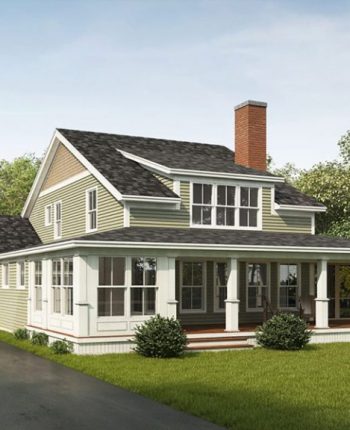
When Janet Taft decided to move from North Hampton, Mass. to Newbury, N.H. in 2018, she immediately began searching for a builder who was as passionate about constructing a net zero home as she was, both for reasons of energy efficiency and air quality.
“I wanted a mold-free home, but I also wanted to be a driving force to reduce my carbon footprint and to show some leadership to our children that it is very important to reduce our energy usage,” Janet says.
For her energy efficiency efforts, Janet earned first place in the second annual NHSaves’ Drive to Net Zero Competition, introduced through the utility collaboration of NHSaves in 2017 as a design and build competition for single- and multi-family homes. Prizes are $5,000 for first place, $2,000 for second and $1,000 for third. Seven homes were entered for 2018.
Net zero homes produce as much energy as they consume by minimizing energy use through efficiency and meeting their remaining needs through renewable energy systems. The Drive to Net Zero Competition weighs five criteria, including the cost effectiveness of the project, the home’s total estimated energy use and, most notably, a home’s score on the nationally-recognized Home Energy Rating System Index (HERS).
Finding the right builder
Janet built a relationship with Unity Homes of Walpole, which is part of the Bensonwood family of companies that has been constructing energy efficient homes since the 1970s. She also worked closely with Michael Loughlin, Energy Efficiency Services Program Manager for Eversource, and Bruce Bennett, the HERS rater hired by Eversource to help guide Janet through the design of the home and claim the many rebates and incentives offered through the NHSaves ENERGY STAR® Homes program.
“We have found that builders are really receptive to the idea of ENERGY STAR® homes, and that’s the first step to getting to a net zero home,” Loughlin says. “It’s the combination of the builder willing to do it and the homeowner asking for it.”
The 3,570-square-foot Taft residence features high-performance LED lighting, triple-glazed European-style tilt/turn windows and 19.1 kilowatts of solar photovoltaics.
“We built a big house, but what I learned through this process is that this can also be achieved with smaller houses,” Janet says. “The size of the house doesn’t matter.”
She was pleased that insulation, windows and doors were pre-installed at Unity’s factory, therefore preventing what is called “builder’s mold,” which can occur when a structure sits in the elements for months.
“The house was set up on site in six days,” Janet says. “The shell and roof were on, and when the rain came, we were buttoned up. Unity was great to work with, and they are very much ahead of the curve on indoor air quality.”
Unity also made it easy for Janet to realize the incentives and rebates offered by filing all the necessary paperwork with Eversource, a utility partner of NHSaves.
“We have streamlined the process so that it’s smooth for the builder, whether you are building your first energy efficient home or have already done a bunch,” Loughlin says. “It is very much a team process. The HERS rater knows all the rebates that are available, so he can help the homeowner and the builder because he’s the one doing the on-site inspection.”
Quickly reaping benefits from her investment, Janet’s electric bills now average less than $13 per month, while the air-tight home is quiet and maintains an even temperature throughout the year. “I’m proud of the energy efficiency of this home and the intelligent way it was built,” she says. “It is super tight, but we still have fresh air circulating and there is minimal loss to heating and cooling. I feel like I have done something responsible.”
Combining sensibility with technology
Mark and Liz Peterson, who won second place, wanted to escape the summer traffic on Cape Cod and retreated to the New Hampshire countryside in Sutton. A builder himself, Mark wanted to design a home that reflected his Yankee sensibility but was also technologically advanced.
The Petersons hired Matthew O’Clair General Contracting after visiting O’Clair at one of his impressive work sites. “He didn’t know I was looking at his work,” Mark says. “It looked very well done, and he was very receptive to building a net zero home.
“The Peterson home was a fun build, because I was working with products that I don’t generally work with every day, learning new connections and details, and how to tie the concrete walls and all the foam together along with the standard roof truss connections,” O’Clair says.
On Cape Cod, the Petersons were averaging $160 per month on electricity. Since moving into their net zero home, that monthly bill has plummeted to around $12.
“The temperature control, the humidity control and the environment in the house is much cleaner than I thought it would be,” Liz says. “Plus, there are no drafts!”
O’Clair worked closely with Mark on the build. “Mark has been a builder his whole life, so he knew a lot about the mechanical stuff,” O’Clair says. “He really wanted to build an energy efficient home and cut down on maintenance costs down the road.”
The modest 1,536-square-foot ranch-style home has an insulated concrete forms wall system, as well as 39 solar panels on a standing seam metal roof. There are several different mechanical systems.
“It has Mitsubishi ductless mini splits, which are very efficient for heat,” O’Clair says. “And because the house is so tight, we installed an air handler system for proper air exchanges, and the domestic hot water system is a supersaver tank that comes off a boiler.”
The Petersons also worked with Eversource’s Loughlin throughout the project. “Michael was very instrumental in helping us out,” Mark says. “He answered a lot of questions and spent a lot of time on the phone with us. I was able to reach him directly, which was important, because I’m a straight-talk guy and I got my answers.”
“We built a great relationship, almost like a friendship,” Loughlin says. “It was great to see the house come together and for the Petersons to be happy with the final result.”
Practicing what you preach
Third place in the Drive to Net Zero Competition went to Bruce Williamson, owner of Domus Custom Builders, and his wife, Wendy. They worked closely with Liberty Utilities, their NHSaves energy partner.
The Williamsons’ 5,760-square-foot home in Etna features a push-button activated hot water system that reduces water use; triple-glazed windows; and a ground-mounted solar PV system that pivots to track solar throughout the day, regardless of the season.
The traditional New England-style home has many custom features, including a first-floor master suite with wide doorways to accommodate any future health issues, and high-end interior finishes. The house is oriented true solar south for passive solar gains, while the wall sheathing is air-sealed with advanced flashing and tape that minimizes air leakage.
“Bruce builds homes for a living and it was really interesting to see what he took from all those years of building homes for other people and applied it to his own home,” says Matt Minghella, Residential Program Manager for Liberty. “There are some really creative touches.”
The goal for the project, Bruce said, was to prove that a “high-end” home could be built to net zero standards. “Many people are more interested in the look than energy conservation,” he says. “We set out to prove you can have both.”


